Francesca and Henk-Jan's Backpacking Trip!
Friday, October 2, 2009
Sydney: The Finale
The next exhibition told the story of the Australian Navy. Francesca and I learned how all their most prized ships basically got taken out during the first or second time they saw action. We saw how the Marines sleep and Francesca climbed in a model-bunk. We also played a game that had us apply to the Navy as rookies and guess what the sounds were that we heard from within our submarine. We kicked ass and were eventually promoted to Commander of our ship.
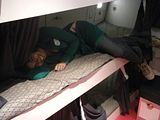

Swimming and surfing are very big sports in Australia, so it was no surprise there was also a rather large section dedicated to the history of said water-activities. We learned how Australia became such a big swimming-nation (think Thorpe) and how many of the world’s best surfers come from Down Under. The development of swimwear over the years was also discussed to some extent and we discovered that the first bathing suits for women were made of wool. As wool absorbs water, the ‘cozzies’ would soon get heavy, sometimes with unfortunate consequences. We also saw how the world’s most talked about piece of swimwear found its spot in the limelight: the Speedo.
From humans in the water to humans on ships: in the first years after settling Australia thrived on whaling. Francesca and I read descriptions of the first, often dangerous and sometimes deadly attempts with little rowing boats and simple harpoons. Later on cannons were introduced and whaling became much easier. It was heart-breaking for me to see more recent images of whales being killed and hauled in, jaws broken in the process. We also read and saw what happened to the whale after it was killed: the oil was extracted in a disgusting and time-consuming manner, the meat was sold as meat for animals and the rest was used to make artifacts, such as small chairs (with one vertebra).
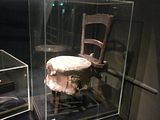
Time started running short for us so we headed to the last part of the museum we hadn’t seen: a special exhibition called ‘Exposed: the story of swimwear,’ another, but more detailed, description of the history of bathing suits for women. We learned that the first women that started wearing swimwear not just on the beach were actually arrested for indecent exposure! A catwalk had been designed with mannequins displaying different swimwear from various decades. At first, pretty much the whole body was covered; eventually, almost everything was exposed. In 1964 a bold designer came up with the world’s first topless swimsuit. It was denounced by the Vatican and sparked a worldwide debate over women appearing topless while swimming or sunbathing.
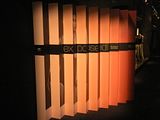
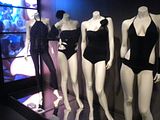
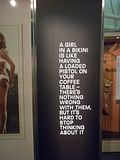
Unfortunately, the museum was about to close so we headed around the back to the harbor and checked out the replicas of several ships they had moored there. Francesca and I saw an old submarine, a destroyer and an old three-master. It was getting chilly outside, so we walked back to the hostel and had dinner. I wanted to show Francesca ‘Boondock Saints,’ so we laid down and watched that movie, falling asleep satisfied and tired after a long day.


Tuesday we finally got around to doing the free city tour that we had missed out on previously. We met at the Town Hall around 10:30AM, and with a group of about 10 people and our guide Ross we went to explore the city. He explained how the land where Town Hall stands nowadays used to be a cemetery on the outskirts of the earlier settlement. As the city grew the cemetery was surrounded by housing. The dead unfortunately smelled rather bad, and eventually were unearthed and moved to a new location. Town Hall’s location was now free for construction.
Our next stop was Queen Victoria’s Statue, which we had already seen. The Statue once stood in Dublin, but the Irish didn’t want it anymore and so it got shipped to Australia. What we didn’t know was that the Queen’s little dog also came with her. There’s a smaller statue dedicated to her pet, which talks if you throw coins in the water. Ross then took us inside, explaining the history of the building. The Queen Victoria’s Building (or QVB as Sydneysiders call it) was originally built as a market, but the small walkways and many floors made it hard to trade inside. Over the years there were many plans to take it down, but the locals always protested. In the 1980s it was bought by a Malaysian-based company, and finally restored to its current state. Ross also showed us the two hanging clocks, one of which contains a letter written by the Queen, not to be opened for another 70-odd years; the other has a little show in which King George the Second gets decapitated. We continued by crossing underground to Pitt St. Mall, one of the city’s oldest malls.
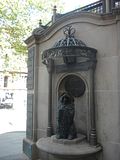
Once outside, Ross took us to St. Mary’s Cathedral. We didn’t have time to go inside; Ross left it to us to visit it later and take more time to explore it. He did tell us the story of the fountain in front of the cathedral. Its construction had been ordered by an Australian Francophile and the fountain was to exemplify the strong bonds between France and Australia. The design itself doesn’t seem to show too much to back this up as it contains sculptures of scantily clad men holding sheep by the horns. French people are strange…
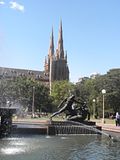
On the way to Circular Quay Ross pointed out the Barracks, which had been built to contain the convicts that were causing a ruckus in the city. He also showed us the Sydney ‘Rum’ Hospital. The city’s architect really wanted a hospital, but the English government hadn’t wanted to pay. He sold the rights to rum-sales to three businessmen under the condition they paid for the construction of a hospital. The hospital had been way too big, and soon wings were closed and used for different purposes. One of them is now used by Parliament.
We then walked past ‘Il Porcellino,’ a statue of a boar given to Sydney by an Italian organization. Legend says that if you rub the nose of the boar, you will be endowed with good fortune.

Francesca and I followed Ross and entered a sea of schoolgirls with funny hats, whilst checking out Channel 7’s headquarters, the Australian Currency Museum and the Commonwealth Bank of Australia. The Museum was free, but again we didn’t get the time to check it out. Francesca and I concluded we’d have to come back and have a look inside later. The news station was shooting as we walked past, and gave me a chance to play with the reflection of businessmen in the glass, and the host behind it. Walking along we passed a sculpture of a businessman on a bench. Very realistic and quite surreal.
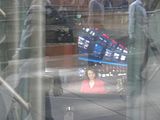
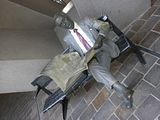
Our tour continued and we saw the First Fleet Memorial, dedicated to the arrival of the first European settlers. Another memorial, that I thought looked like two doughnuts hugging, commemorated the tight connections between England and Australia, with the concrete slabs on which the memorials rest being from the other country. We finally arrived at Circular Quay, part of the original harbor and shoreline of Sydney. We entered the Custom’s House and saw it had been turned into a gallery.
Leaving Circular Quay we headed for 'The Rocks,' the first place the settlers set foot on land. A wooden monument with the figures of settlers, soldiers and convicts showed the kind of people that arrived on those first ships. We saw some examples of the first housing created for the harbor-employees. We walked from one side of the rocks, through a tunnel, to the other side. The tunnel had been a time-consuming project as at first convicts were used to break their way through. They kept failing, so eventually dynamite was used to make a tunnel.
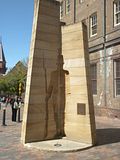
On the other side we found a cool pub called ‘The Hero of Waterloo’ with a not-so-cool infamous story. Ross told us how the barman had an interesting way of introducing some new guys to the pub. More than half of the drinks would be completely free! Sounds good right? As the night continued the new guy would get more and more drunk, eventually too wasted to walk properly. He would go to the bar for one more beer, and… suddenly the floor would disappear under him. The barman would walk up and calmly give the drunk his beer, closing the hole back up. The guy would fall asleep eventually, and wake up the next morning on a ship. Whether he liked it or not, he had to work to stay alive. Some people use rather drastic headhunting techniques.

Francesca liked a statue made by an American weirdo (I mean artist of course), who bought a little car, parked it in the middle of a street and threw a giant boulder on top of it. It’s still there now, scaring the hell out of drivers every day.
Our tour was coming to an end as Ross led us under the Harbour Bridge, with a view of the Opera House in the background. We already knew the story of the Opera House, so we zoned out a little in the sun. We woke back up when Ross spoke of the Luna Park across the water. If you remember the Park in St. Kilda, Melbourne you’ll see the resemblance. This face however, is not evil; it has a big smile. The park has seen some accidents, with the ghost house burning up and the rollercoaster being too noisy. In an attempt to up the tourism the face was changed to show a bigger smile.
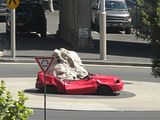
We thanked Ross for his interesting tour, and headed back for the museums and other points of interest we had missed. Our first stop was the Museum of Contemporary Art (or MCA), which Francesca at first had thought was called YMCA. Entry was free, and we even managed to catch five minutes of the free tour. The guide showed us two works of art. The first was two colorful walls being held up by colorful beams, with the colors representing different countries and the international organizations they were part of. This art piece posed the question whether the world relies/balances on those beams, or if the beams (organizations) are only there as useless extras. The second piece of art showed the world as an architect’s open floorplan of a new living room, with the countries all interconnected, showing the maker’s want for a united world.
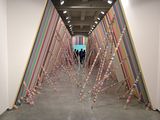
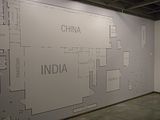
Francesca also got to make her own piece of art on another floor within the complex. A wall with a bench had been set up with stamps of birds, which people could either stamp on the wall or a sheet of paper. She made me a great work of art! An even more vivid and contemporary work we saw included water, child-like drawings and ornaments and grassy sculptures.
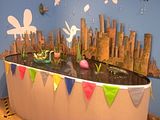

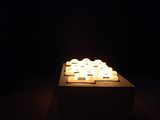
Next up was the Art Gallery of New South Wales, where Francesca and I found another free exhibition. The first section was dedicated to the classical masters of Europe with a lot of pieces that I found really interesting. I’m more of a fan of the grand, realistic depictions of battles. Francesca found some more surreal pieces that we also spent some time looking at. Unfortunately, the free section wasn’t that awe-inspiring, and our time-frame was rather small, so we decided to go for our next target.


This brings us to the Mint, where they had a small museum dedicated to Australia’s fairly unique currency: the Museum of Australian Currency Notes. We thought we were too late, as closing time for them was about five minutes away, but the kind receptionist let us in anyway, and thus Francesca and I got to read all about the history of Australian money. We read how in 1963 the Australians switched from the pound to a new currency, at that point unnamed. Several entries were considered, with ‘Roo,’ ‘Digger,’ ‘Kwid’ and ‘Dinkum’ as possibilities, but ‘Royal’ won in the end. The people on the street complained heavily and in the end the government changed it to ‘Dollar,’ the name that stuck.
We also listened to a song that was used at the time to alert people about the upcoming change. Here’s a little excerpt:
In come the dollars and in come the cents
to replace the pounds, the shillings and the pence.
Be prepared folks when the coins begin to mix,
on the 14th of February 1966.
The song came with a handy explanation of why the decimal system was so much easier to use. We both thought it was amusing to see the state of television at the time, and the way they made their ads those days.
There was one problem with the new dollars: a lot of counterfeits soon appeared. Constantly changing the notes helped, but wasn’t the real answer. The government started looking for a more permanent solution, and research in the 70s and 80s saw the arrival of the polymer (‘plastic’). Polymer opened the way for new security measures (e.g. a 3d image in see through plastic), and on Australia Day 1988 the first note was introduced.
Polymer had another advantage over traditional paper: Polymer notes last about four times longer than paper notes. The notes are much sturdier and can be recycled. Several countries have switched to Polymer notes since its invention, and more are still to come. Francesca and I agreed that it’s strange the Euro and Dollar still rely on old-school paper, where Polymer would be the environmentally correct choice. We thanked the receptionist for letting us in, and headed for our next stop.
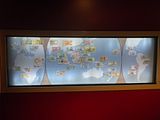
The ‘Hyde Park Barracks Museum’ was, as I explained earlier, used to contain the British convicts at night. At first, they weren’t jailed at all: they had nowhere to go and would die. However, as the city grew the criminals started causing more trouble: they were robbing each other and formed gangs. The barracks were built to keep them and their city safe during nighttime, when they’d be most prone to cause a mess.
Unfortunately, this exhibition wasn’t free, so we just took a long walk around the outside of the building, checking out some of the quarters on the courtyard that were free of charge. I read a humorous quote from the time it was built, saying the courtroom had been designed so poorly that on hot days the ventilation would get so bad the people in the court fell asleep or even fainted. Some architect!
Our final cultural stop of this action-packed day was St. Mary’s Cathedral. We had wanted to check out the ‘interesting crypt,’ as the brochures described it, but found the crypt had already closed. In fact, the cathedral was quite full, with lots of people attending a school choir. Francesca and I sat down, taking in the murals, the mosaic glass and the strangely orange hue the cathedral had. Always an impressive sight!
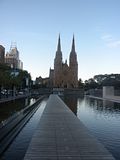
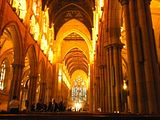
We headed back to the hostel walking past a cool fountain, and after this, because we knew our flight to Cairns was coming early the next morning. Dinner and a movie did it for us. I packed the bags and after a few hours of sleep I got to the take them downstairs, where we were picked up by a shuttle-driver who took us to our destination.
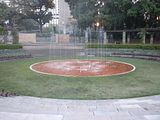
Ciao,
Henk
Monday, September 28, 2009
Yopals!!
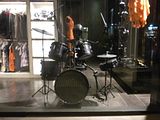
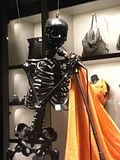
We visited one of the grocery stores to grab a drink, then picked up dinner at Subway, then returned to the Internet café to talk to Henk’s Mom on Skype and download a few more movies.
Sunday we attempted to get our great buffet deal again, but it wasn’t running, so we went to a food court across from Pitt Street Mall, grabbing a decent butter chicken and a banana smoothie. The majority of Sunday was spent window-shopping! We walked through a bunch of malls and little shopping streets. Henk and I also had the chance to visit the National Opal Museum (museum, with a dinosaur display, but mostly store!) and ‘cash in’ our free Opal gift tickets.


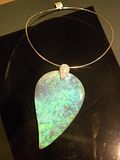
The museum explained the Aboriginal Australian ‘Dreamtime’ story of the opal. It basically goes like this:
‘The Dreamtime creator came down to Earth in a giant rainbow. He gathered together all the tribes and he told them of the laws they were to follow, and he told them he would return when he thought they were wise enough to carry out his plan to have peace forever on Earth. He said they would know when the time had come by the rainbow that would appear in the sky. It would be much bigger and brighter than they had ever seen before and the shape would be so different that they couldn’t mistake it. On the Morillah – the stony ridges where the rainbow had rested while he waited for the Dreamtime creator – there was a giant area of rocks and pebbles. The sun rose the next morning, shining its light on the rocks and pebbles, having all the colors of the rainbow – the first opals.’
I predicted that we were going to get an extremely rough opal rock from our free tickets, but our gift was actually a really cool kangaroo pin with a tiny polished opal in it! Nice! We even picked up an extra opal pin as a gift for my Uncle Randy, since he told us he really wanted an opal from Australia. (We usually get him ‘Hard Rock Café’ pins, but we have yet to find a Hard Rock Café on this trip!!) UNCLE RANDY, HERE IS YOUR GIFT!
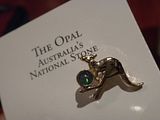
Anyways, next we walked towards the Opera House again, because it was a beautiful day, and I really thought we should just spend more time admiring the awesomeness of Sydney’s architectural masterpiece. While we were near the Harbour, we read about another Aboriginal story, this time about ‘Mimi Spirits.’ Mimi Spirits are ‘tall, thin beings that live in the rocky northern Australia as spirits. Before the coming of the Aboriginal people, they had human forms. The Mimi are generally harmless but on occasion can be mischievous. When Aboriginal people first came to northern Australia, the Mimi taught them how to hunt and cook kangaroos and other animals. They also did the first rock paintings and taught Aboriginal people how to paint.'
Here is an Aboriginal artistic interpretation of Mimi Spirits!
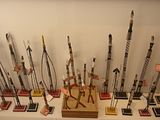
As we walked back towards the hostel, I was feeling like a snack, and Henk and I ended up splitting a Red Velvet cupcake. Delicious! Topped with cream-cheese buttercream and a red sugar heart!
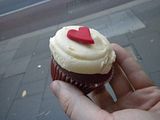
We continued our shopping that evening in the Queen Victoria Building, but we’ll tell you about that building a bit later. I will let you all know that we spent time there dressing Henk up as an Australian cowboy! He looks pretty good in that hat, I have to say. :P
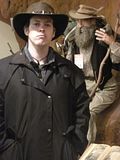
Talk to everyone later,
Francesca
